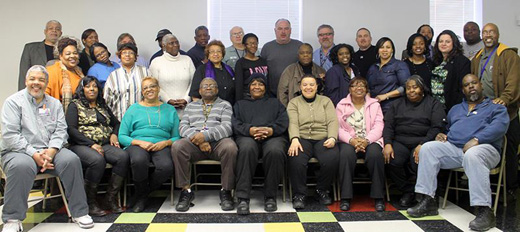
BALTIMORE – 2,100 service, maintenance and technical workers of 1199SEIU United Healthcare Workers-East and the Johns Hopkins Hospital reached a contract agreement on July 11 ending a four month dispute. The hard-fought negotiations process that led up to the contract was highlighted first by a three-day strike in late April and then by a mass rally on Mother’s Day. A planned four-day strike scheduled to begin June 27th was averted when Maryland Governor Martin O’Malley asked both sides to go back to the table to resolve their proposal differences. The parties held two more bargaining sessions after O’Malley’s request, and reached a tentative agreement on July 8. 93 percent of the membership voting on July 10 and 11 approved the contract.
John Reid, Exec. Vice President of the union, said of the contract, “This is an important victory for patients and workers all across Baltimore. Johns Hopkins Hospital sets the standard for healthcare in our city and that standard has just been raised.”
The new contract provides low-paid 1199 SEIU workers with raises as high as 38 percent, as much as $4.30 an hour in some cases, over the life of the 4½-year contract. The employees also won a $15-an-hour minimum wage that will apply immediately to workers with 20 years of service. There will be across-the-board raises of at least 2 percent every year, with a 2.75 percent raise in 2017, bringing workers with 15 years of service above $15. The $15/hr demand has gained nationwide recognition by the ongoing struggles of fast food workers in many cities, some of whom are also represented by SEIU, in their demand for higher wages and better working conditions. While Hopkins workers won’t be flush with cash – wages will remain as low as $13 an hour for many – they will be making more than the $12.25 minimum Hopkins had been offering and well above what they make now.
The contract represents a significant improvement over what Hopkins management had called its last, best and final wage offer in early April when Hopkins workers struck. The April strike was enthusiastically supported not only by the Hopkins workers, but also by 400,000 1199SEIU HCW-E members up and down the East Coast, and by Hopkins medical students who walked the picket line and spoke at rallies during the strike and at the union’s “Mothers March for Justice” rally on Mother’s Day. Broad support also came from the labor movement and supporters in the area. The actions are indicative of the history of the local, which was first recognized by Hopkins in 1969 after Coretta Scott King came to support the workers’ recognition strike, almost exactly a year after Martin Luther King Jr. was assassinated in another workers struggle in Memphis.
In what was described as “a win-win for Hopkins,” a Baltimore Sun editorial said, “the tentative contract reached early Tuesday … represents a victory not only for the hospital and members of 1199SEIU … but for Baltimore. The contract raises wages, in some case dramatically so, allowing Hopkins to set an example of what a ‘living wage’ can mean for the health and security of workers in this city.”
Hopkins thus can join a growing number of businesses in retail, food service and other sectors that are paying entry-level workers well above the minimum wage – a decision they say boosts productivity, reduces turnover and ultimately benefits the bottom line. Raising basic compensation to a higher standard can be good for workers and employers alike, reducing dependence on public assistance and creating more job opportunities in the future.
A July 8, 2014, Baltimore Brew article by Mark Reutter called the agreement “a textbook example of a sharply focused campaign that combined old-fashioned union organizing with modern social media.”
To Reuter’s point and filling the hospital’s official ‘no comment,’ the union kept plugging away with videos, testimonials and embarrassing on-line posts with titles like “Hypocrisy at Hopkins” and “$1 Billion for Buildings.” On its website http://hardshipathopkins.org/ 1199SEIU had video clips of hard-pressed Hopkins workers, tax data on the over-the-top pay of some hospital executives, and emphasized its historical connection to Coretta Scott King.
Many felt that the workers willingness to strike Hopkins a second time may have helped Hopkins move off their previous “best final offer” of annual 2 percent pay raises and a minimum wage of only $12.25 by the end of the 4½ year contract.
“DARE TO FIGHT – DARE TO WIN!” summed up Maryland AFL-CIO President, Fred Mason, Jr. in his congratulations to the women and men of 1199SEIU and their leadership for their unprecedented victory.
Photo: The bargaining team. 1199 SEIU MD/DC’s Photos












Comments